Scenario: A Citrix Architect is using Radius and LDAP as dual-factor authentication. The architect is migrating to Citrix Cloud and wants to retain the same authentication procedure for XenApp and XenDesktop service in Citrix Cloud.
Which deployment strategy should the architect use for Citrix ADC and StoreFront to ensure that the solution complies with the existing security policies of the company without incurring additional costs?
Scenario: IT management has decided which server hardware model to use for new XenApp and XenDesktop Sites and needs guidance on sizing the Hardware Layer.
Click the Exhibit button to view the host details.
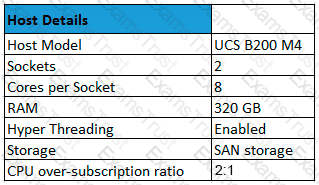
A Citrix Architect is planning to install XenServer 7.x on this host which will be used to host only XenApp servers.
How many XenApp servers can the architect deploy on the host if the plan includes allotting each XenApp server 4 vCPUs, considering the over subscription ratio?
Scenario: A Citrix Architect needs to design a new XenApp and XenDesktop environment.
The architect has determined the applications and characteristics listed in the Exhibit during the application assessment.
Click the Exhibit button to view the list of applications and characteristics.

To which application category does Application1 belong, based on the information provided in the Exhibit?
Scenario: A Citrix Architect is investigating a recent change that is impacting system performance of the Provisioning Services farm. However, no actions have been recorded in the Audit Trail.
Which two processes are preventing Provisioning Services auditing from recording the actions? (Choose two.)
Scenario: A Citrix Architect designed an active/passive XenApp and XenDesktop environment for a customer, where the passive Site serves as the disaster recovery Site for all users.
The architect configured a DFS root for user profiles and redirected folders and configured DFS-R to replicate the user profiles and data to a fileserver in the disaster recovery Site.
During failover testing, no issues were reported; however, today the customer has an unexpected outage in StoreFront on the active Site which causes sessions to start flowing to the passive Site.
The customer reports that several users are experiencing issues logging on and has also stated that Citrix Director is NOT showing any issues for the passive Site.
What is likely causing this issue?
Scenario: A Citrix Architect needs to design a new XenApp and XenDesktop environment. Citrix Provisioning Services has been selected for image management.
Which two RAID levels should the architect use for the storage hosting the Provisioning Service write cache? (Choose two.)
Scenario: A Citrix Architect is reviewing a XenApp and XenDesktop design for an environment with multiple Active Directory forests.
Click the Exhibit button to view the design details.
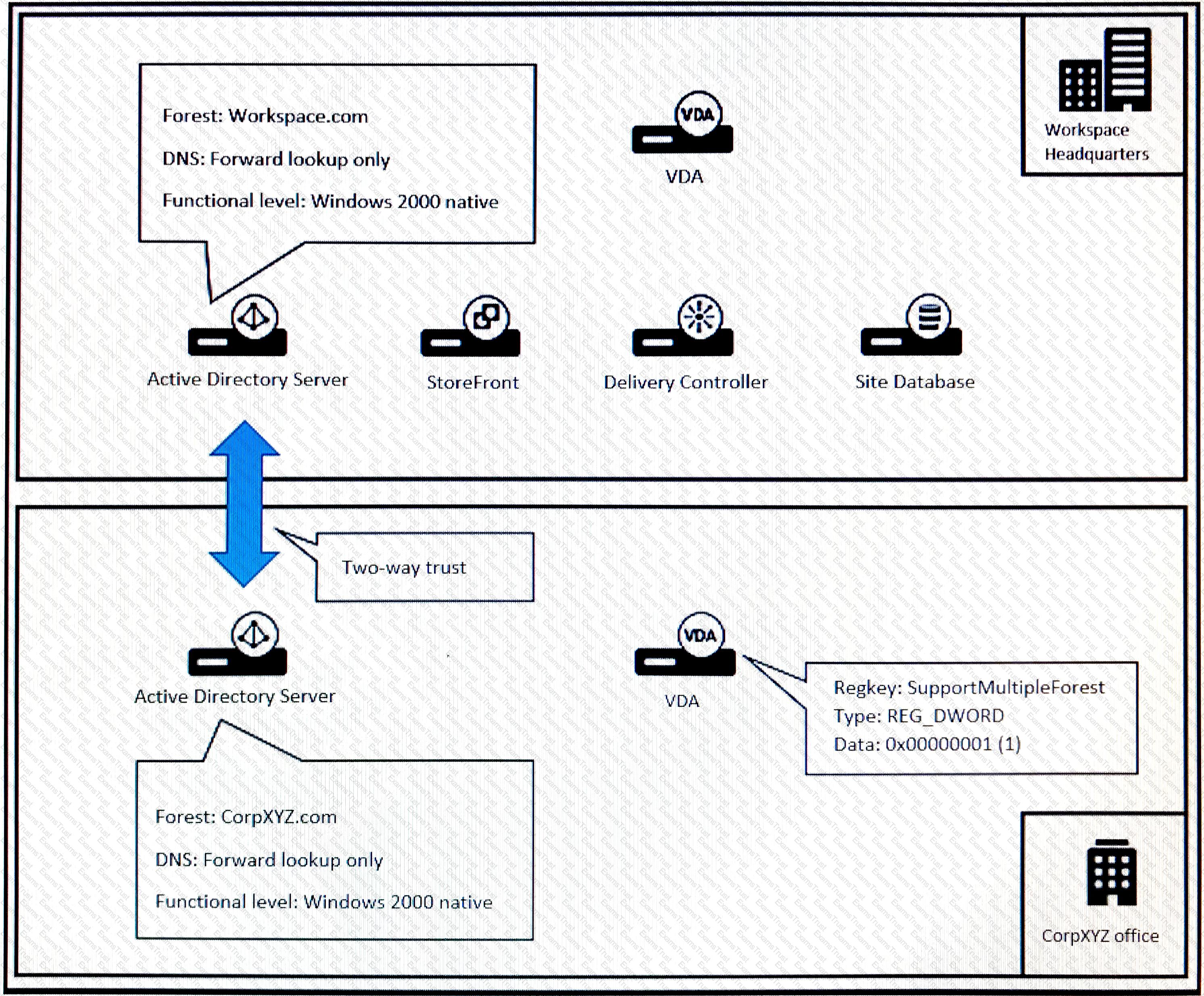
Which risk should the architect highlight to the customer, based on the details listed in the Exhibit?
Scenario: A Citrix Architect needs to design a new XenApp and XenDesktop environment for a bank. After the project kickoff meeting, the following business drivers have been identified and prioritized in the following order:
1. Increase security
2. Reduce costs
3. Improve the user experience
4. Simplify management
Later in the design process, the architect documents the design decisions shown in the Exhibit (only some are shown).
Click the Exhibit button to view the design decisions.
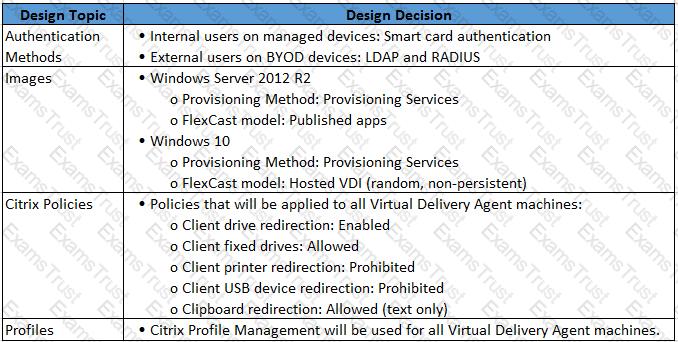
During the quality assurance review, the architect observes that one of these design decisions does NOT align with the business driver priorities.
Which design decision should be changed to match the prioritization of the business drivers?
Scenario: A Citrix Architect needs to design a new XenApp and XenDesktop environment. Currently, the environment is configured with two locations with identical XenDesktop Sites. Each Site has two Delivery Controllers, two StoreFront servers, and one NetScaler high availability pair. The same applications have been published from both Sites for all the users. Two Zones (Zone A and Zone B) are configured in each Site with one Controller in each zone. The Microsoft Exchange server is only accessible from Virtual Delivery Agent (VDA) machines in Zone A in each Site.
The following access requirements have been identified:
How should the architect recommend configuring subscription sync to retain the applications added to Favorites?
Scenario: A Citrix Architect needs to design a multi-datacenter XenApp and XenDesktop environment that will use Provisioning Services (PVS) to manage Virtual Delivery Agent (VDA) machine images. Each datacenter will have a separate Provisioning Services farm. During the design discussions, the architect creates a diagram to depict the way vDisk files will be replicated between PVS farms, based on the available storage for the vDisk Stores.
Click the Exhibit button to view the diagram.

Overall, the customer has identified the following objectives for the image replication process:
Which method should the architect use to replicate the vDisk files between datacenters?
Scenario: A Citrix Architect is designing a new, 2,000-user XenApp and XenDesktop environment. The environment will use Windows Server 2016 for all Site infrastructure components (Delivery Controllers, StoreFront servers, Provisioning Services servers, Citrix Director). Provisioning Services (PVS) will be used to provision Virtual Delivery Agent (VDA) machines. The environment will include two primary use cases:
Within the company there is existing hardware which is hosting non-Citrix workloads. The hardware, which is using a third party hypervisor, has some spare capacity, but NOT enough to support the entire XenApp and XenDesktop environment. As a result, the IT team is planning to purchase additional hardware to support the expected capacity but has NOT determined which hypervisor will be used for that hardware. The IT team would like to utilize the existing hardware and wants to minimize the long-term costs of the solution while still providing a good user experience.
How should the architect design the hypervisor resource pools based on Citrix leading practice?
Scenario: A Citrix Architect is reviewing a XenApp and XenDesktop design for an environment with multiple Active Directory forests.
Click the Exhibit button to view the design details.
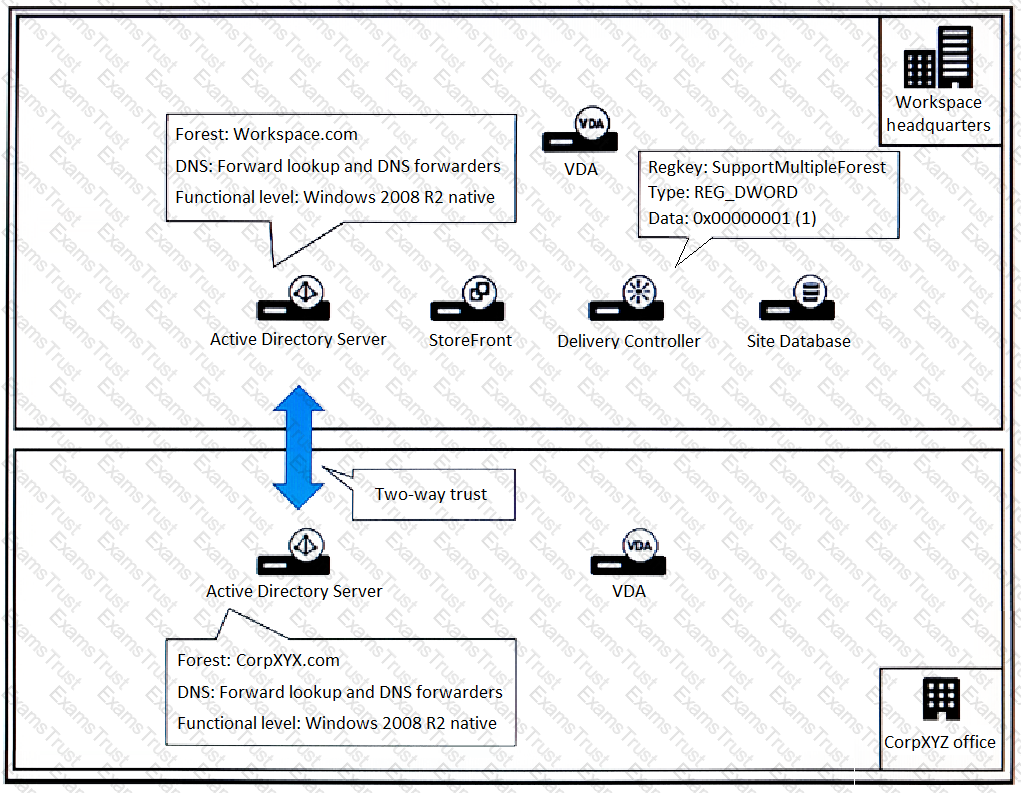
Which risk should the architect highlight to the customer, based on the details listed in the Exhibit?
A Citrix Architect needs to conduct a capabilities assessment for an organization that wants to design and build a new XenApp and XenDesktop environment.
Which four capabilities will directly influence whether the existing Citrix administrative team will have the capacity to support the new environment? (Choose four.)
Scenario: A Citrix Architect needs to design a new XenApp and XenDesktop environment. The architect has identified the requirements, based on the assessment and early stages of the design.
Click the Exhibit button to view the requirements.
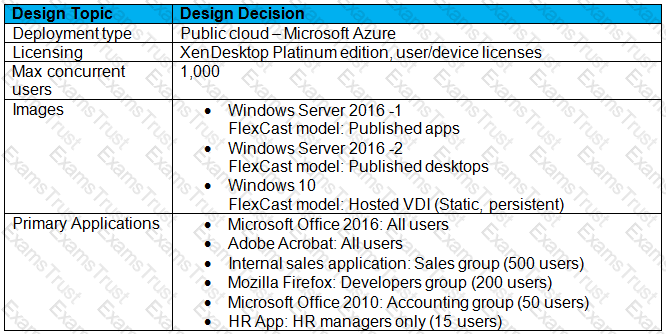
Additionally, the IT team has identified the following general requirements:
Which provisioning method should the architect use for the environment based on the design decisions and requirements shown?
Scenario: A Citrix Architect needs to implement XenApp and XenDesktop. Based on the assessment and early stages of the design, the architect has identified the requirements as shown in the Exhibit.
Click the Exhibit button to view the requirements.
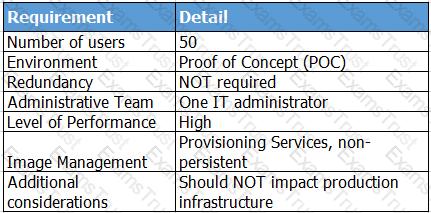
Which tier of storage should the architect consider implementing, based on the requirements in the Exhibit?
Scenario: A Citrix Architect is designing a XenApp and XenDesktop environment and needs to design machine catalogs and Delivery Groups. Users should only be able to access their assigned resources.
Click on the Exhibit button to view the design requirements.
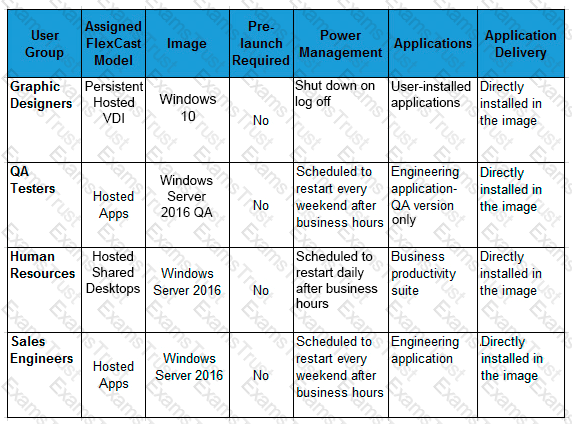
What is the appropriate design using the minimum number of machine catalogs and Delivery Groups, based on the requirements in the Exhibit?
Scenario: While assessing the User Layer, a Citrix Architect finds that most of the internal users connect using corporate-owned laptops, desktop devices, and thin clients. Many of these laptops and desktop devices are running Windows 10, while the remainder of the machines are running Windows 7 and are in the process of being migrated to Windows 10. Some users also connect using personal devices which have Receiver Desktop Lock installed.
Currently, Citrix Receiver is manually installed on any endpoint device added to the company. All these devices use Citrix Receiver version 4.8 and above. The IT team is planning to automate a process to update all the devices with the latest version of Citrix Receiver and to automate another process for automatic installation of Citrix Receiver without incurring extra costs and maintenance.
During the initial testing of the Citrix Receiver Auto-Update feature, the architect observed that the Citrix Receiver Auto-Update feature does NOT work on some of the machines.
Which two reasons could be causing this issue? (Choose two.)
Scenario: A Citrix Architect needs to create a conceptual architecture for a XenApp and XenDesktop environment, on behalf of a retail chain. Based on some initial discussions around the organization’s business goals and objectives, the architect has collected the information as shown in the Exhibit.
Click the Exhibit button to view the information.

Which delivery model should the architect recommend?
Scenario: A Citrix Architect is designing a XenDesktop environment. The Graphic Editors group uses a graphic-intensive and media-rich application. Graphic Editors will be provided with a Windows Server 2016 Desktop with NVIDIA graphics hardware acceleration. HDX 3D Pro and Server VDI options were selected during the command-line installation of the Virtual Delivery Agent (VDA).
Which limitation will affect the Graphic Editors group?
A Citrix Architect is designing a new XenApp and XenDesktop environment. The IT team would like to deploy Windows 10 persistent VDI and Windows Server 2016 non-persistent hosted shared desktops.
The IT team has used physical servers in the past to host the IT infrastructure but would like to move to a hypervisor solution for the new environment. At the same time, the hardware and storage costs for the new deployment should be minimized where possible.
The IT team has requested there are no company-wide outages during hardware updates and maintenance.
The architect should recommend that failover clusters and live migration be used for _____________ and that these resource clusters should use ___________storage. (Choose the correct option to complete the sentence.)
Scenario: A Citrix Architect needs to create a conceptual architecture for a XenApp and XenDesktop environment, on behalf of a retail chain. Based on some initial discussions around the firm's business goals and objectives, the architect has collected the information as shown in the Exhibit.
Click the Exhibit button to view the information.

Which delivery model should the architect recommend?